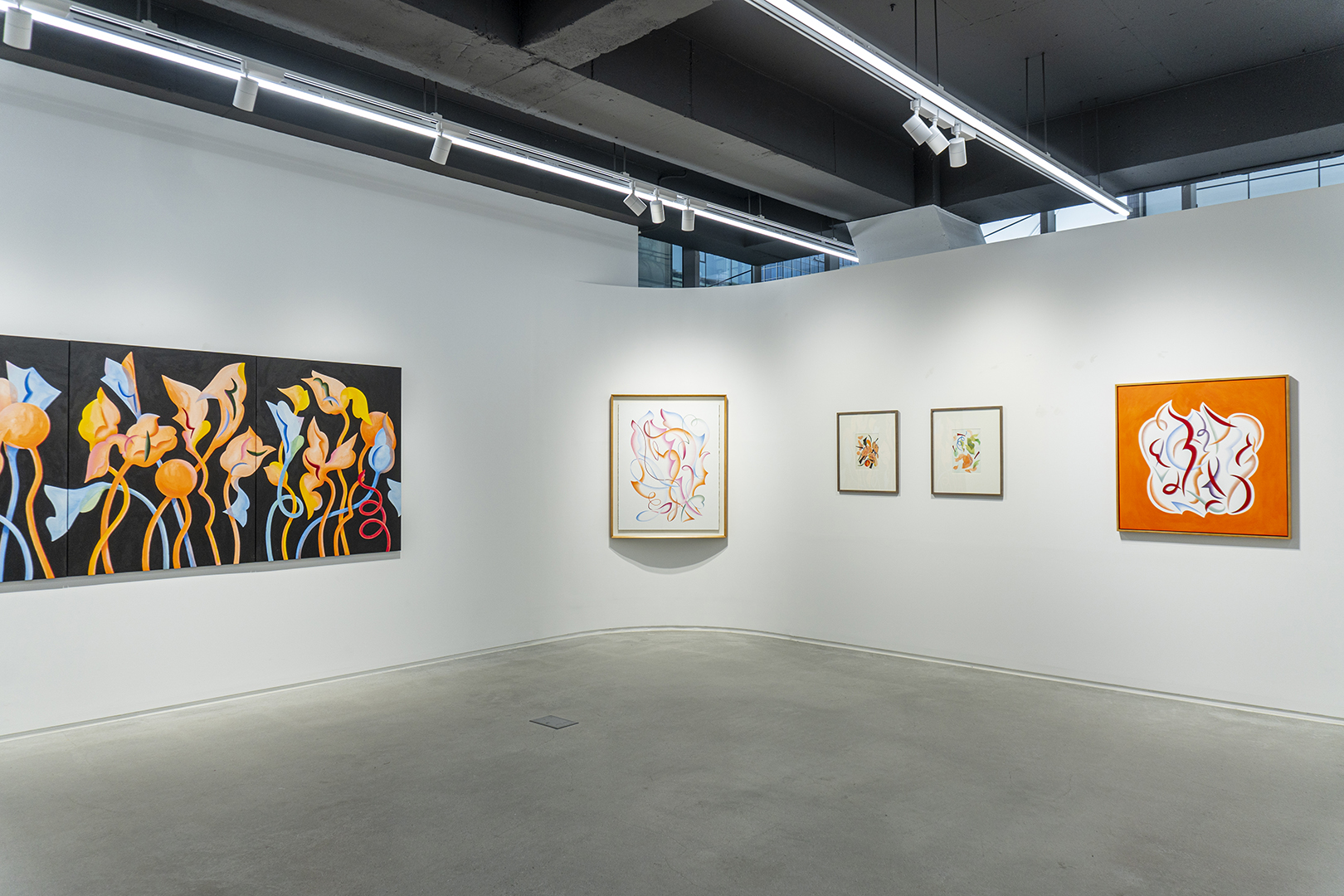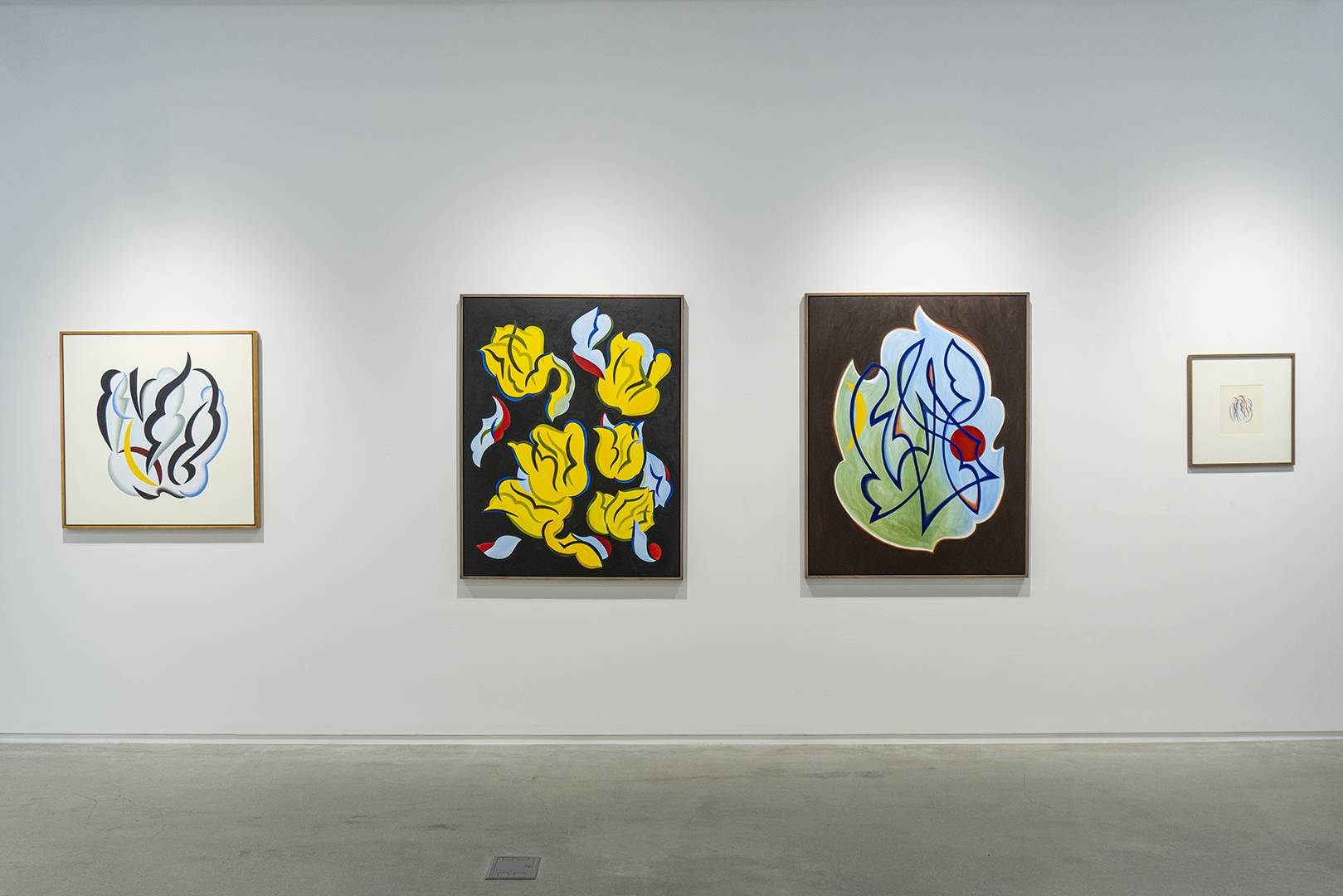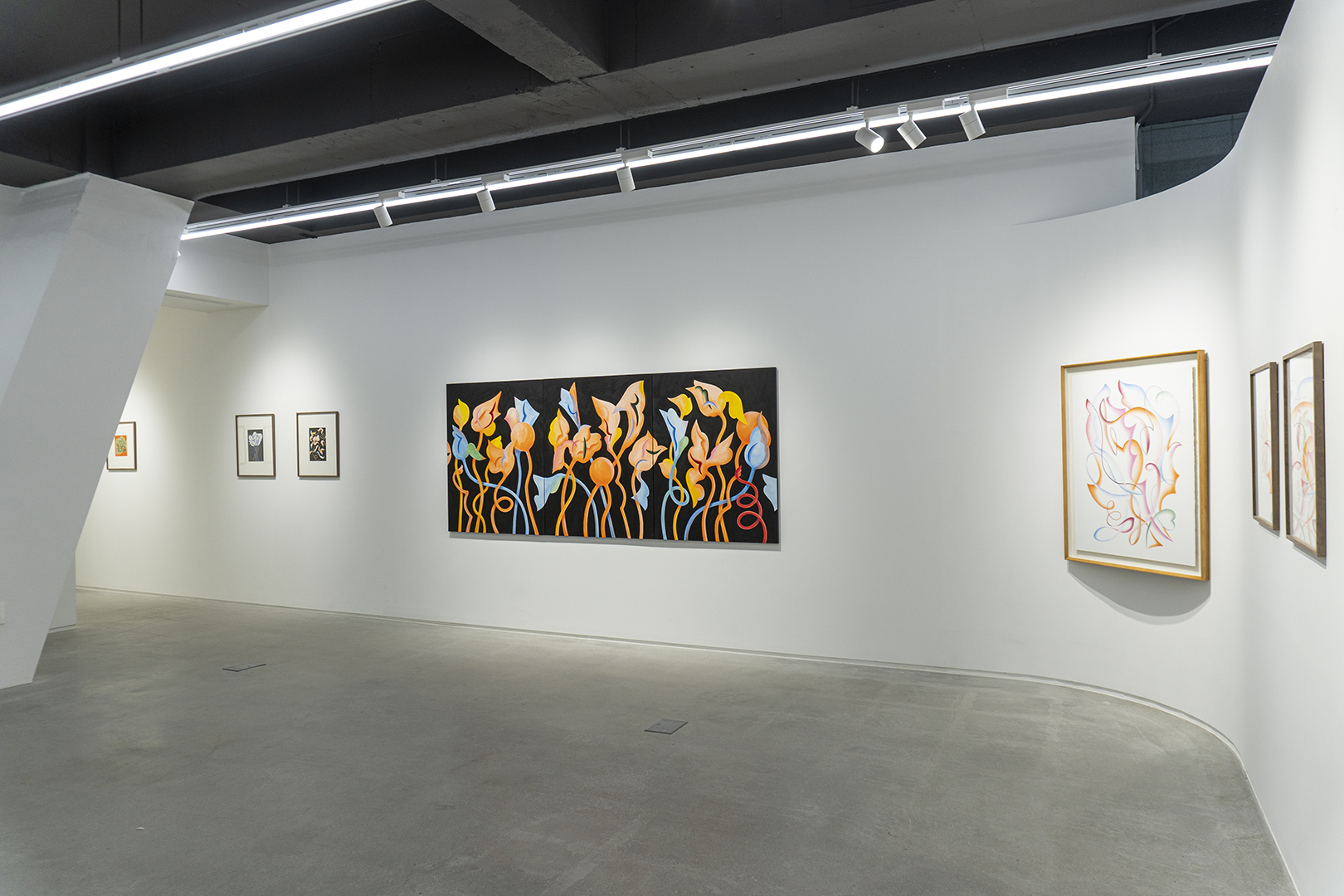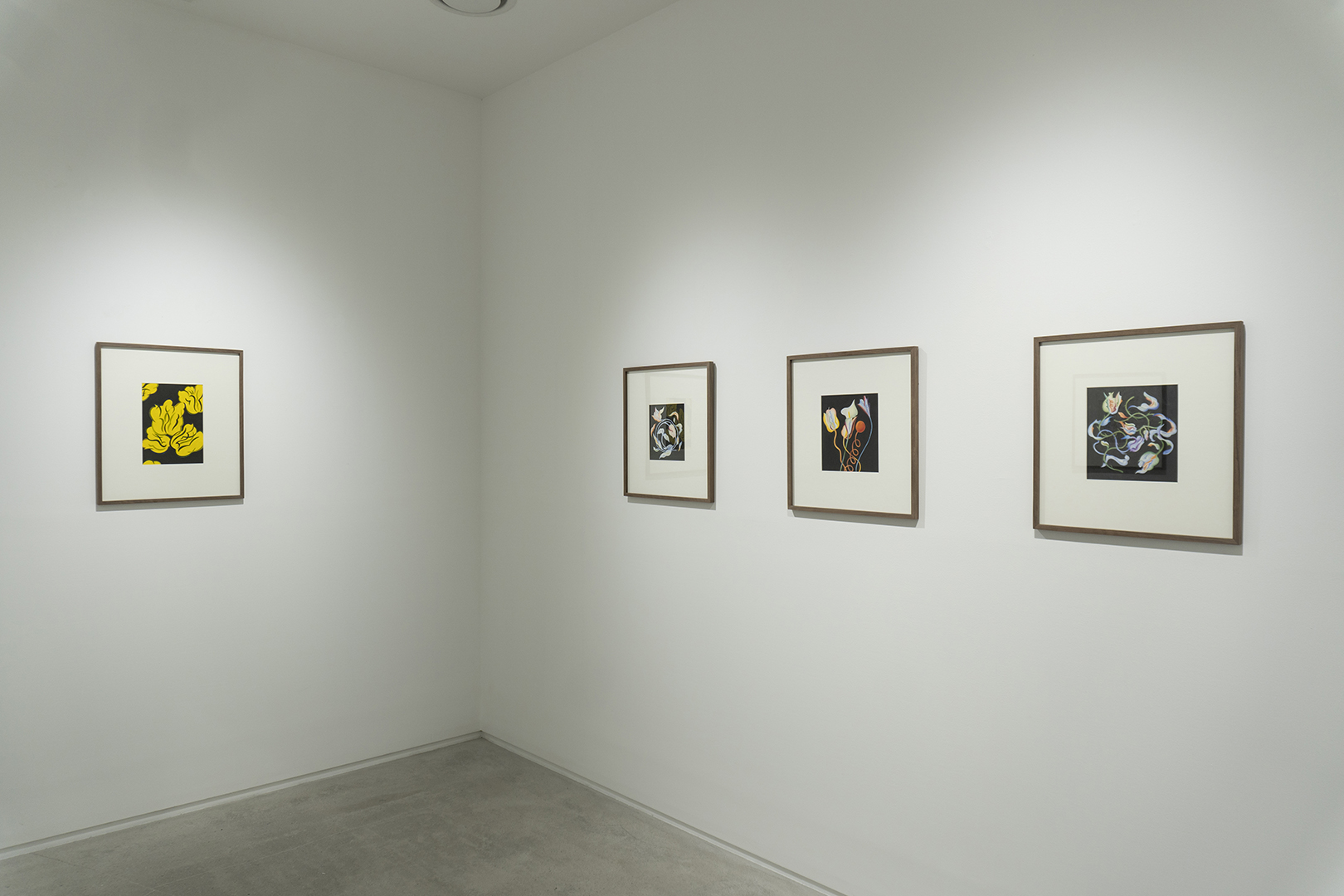NOCTURNE
어지혜
2023년 7월 21일 - 8월 19일
카탈로그
어지혜 작가의 첫 개인전인 《NOCTURNE》은 작가의 무의식 속에 부유하는 에너지를 표현하는 동시에 깊은 내면을 이야기합니다. 어지혜의 작품은 마치 꽃처럼 보이는 다소 추상적인 형태가 화폭을 채우고 있어 관람객에게 독자적인 해석의 여지를 제공합니다. 작가가 그리는 이 추상적 형태는 여성의 부드러운 형상에서 시작되어 각각의 개인이 가진 내면의 에너지가 다양한 모습으로 피어나는 과정을 보여줍니다. 또한, 주로 아크릴과 색연필로 이루어진 선명한 색의 대비를 통해 여름의 밝고 생명력 넘치는 에너지를 전달하기도 합니다. 작가는 여름과 겨울의 명암, 빛나는 순간과 어두운 순간의 찰나를 함께 이야기하며, 이러한 작품을 통해 자신이 삶을 대하는 태도를 관람객에게 시사합니다. 이번 전시가 스스로 각자의 내면에 담긴 고유한 에너지를 감각화하는 경험을 제공하고 이를 공유하는 자리가 되길 희망합니다.
어지혜
2023년 7월 21일 - 8월 19일
카탈로그
어지혜 작가의 첫 개인전인 《NOCTURNE》은 작가의 무의식 속에 부유하는 에너지를 표현하는 동시에 깊은 내면을 이야기합니다. 어지혜의 작품은 마치 꽃처럼 보이는 다소 추상적인 형태가 화폭을 채우고 있어 관람객에게 독자적인 해석의 여지를 제공합니다. 작가가 그리는 이 추상적 형태는 여성의 부드러운 형상에서 시작되어 각각의 개인이 가진 내면의 에너지가 다양한 모습으로 피어나는 과정을 보여줍니다. 또한, 주로 아크릴과 색연필로 이루어진 선명한 색의 대비를 통해 여름의 밝고 생명력 넘치는 에너지를 전달하기도 합니다. 작가는 여름과 겨울의 명암, 빛나는 순간과 어두운 순간의 찰나를 함께 이야기하며, 이러한 작품을 통해 자신이 삶을 대하는 태도를 관람객에게 시사합니다. 이번 전시가 스스로 각자의 내면에 담긴 고유한 에너지를 감각화하는 경험을 제공하고 이를 공유하는 자리가 되길 희망합니다.









A Jihye is like a seed. It's a metaphor for infinite possibilities with no set shape. They also symbolize the vividness and green vitality of life as winter melts, spring germinates, and summer blooms. Such is the case with A Jihye's work. The ever-growing thoughts, feelings, and energies that have been crouching inside of us are refined and bloomed on the screen. The artist's struggle to sense intangible images and capture them as much as possible is evident. Just as everyone has a time of growth and a moment of blooming, the hidden emotions and stories that have been submerged deep in her heart for a long time are about to bloom on this summer night, as if they were confessions.
A Jihye's first solo exhibition <NOCTURNE> takes its name from the word 'Nocturne', which means nocturnal song. This word, which mainly refers to lyrical piano pieces that represent the atmosphere of a quiet night, can also be used to mean 'works about night' or 'works dealing with night scenes'. The works in this exhibition, the artist explains, resemble nocturnes that bloom on summer nights. Her works bloom at night, with somewhat abstract shapes that look like flowers filling the canvas, leaving room for the viewer's own interpretation. These abstract forms begin with the soft shapes of women and show how each individual's inner energy blossoms into different forms. They also convey the bright and vibrant energy of summer through the vivid contrast of colors, mainly acrylic and colored pencil. This is why A Jihye described it as a nocturne that blooms on a summer night. The artist talks about the contrast between summer and winter, the moments of light and darkness, and through these works, she hopes to give the viewer a sense of her own attitude towards life.
The fluid lines, surfaces, and color compositions that populate her work capture the ever-blooming human mind and heart. This is similarly true of A Jihye's work, as most of it exists in a form that is constantly flowing or floating rather than settling somewhere. The backgrounds of her works are often black or very darkly colored because she visualizes looking into the mind in a meditative way. Just as the mind is never the same, A Jihye's work is constantly in motion as it contains different emotions and thoughts each time. In particular, Dance of Light no.1, which is a composition with a beginning and end connected to each other like Mobius' belt, reminds me of a conductor's gesture, so it looks like a work that depicts music with a kind of rhyme as well as the mobility of the artist's work. The sense of rhythm or musicality in flat paintings is a typical feature of the work of Wassily Kandinsky, a symbol of Western abstraction. According to legend, Kandinsky referred to works that mimic natural shapes as "melodies," and paintings that are freely imagined, free from shapes, as "symphonies. Kandinsky did not stop at imitating the appearance, but sought to break away from the form and capture the artist's inner thoughts and feelings on the canvas. What A Jihye wanted to paint through this exhibition is also a 'nocturne' that blooms on a summer night, so we can see that the two artists have a similar trajectory in their attitudes towards their works and their work.
Kandinsky considered music to be the best teacher, while A Jihye translated the rhythm of music to the canvas. Kandinsky spearheaded the abstract art movement with his fellow painters by creating The Blue Rider, while A Jihye collaborated with other creators in a creative collective called Spectrum Object, sharing and expanding the scope and inspiration of their work. Kandinsky went on to teach at the Bauhaus, a program that has had a profound impact on modern architecture and design, while A Jihye runs her own design studio, Sparks Edition, and mentors students. With similar attitudes toward their work, they believe that they are pursuing similar directions, even if the physical conditions such as time and environment are different. Kandinsky's time spent creating beautiful symphonic paintings has come to an end, but A jihye is just beginning to bloom, starting with NOCTURNE, a nocturne that blooms on a summer night. (Written by Jiyoung Hong, CDA Curator)
A Jihye's first solo exhibition <NOCTURNE> takes its name from the word 'Nocturne', which means nocturnal song. This word, which mainly refers to lyrical piano pieces that represent the atmosphere of a quiet night, can also be used to mean 'works about night' or 'works dealing with night scenes'. The works in this exhibition, the artist explains, resemble nocturnes that bloom on summer nights. Her works bloom at night, with somewhat abstract shapes that look like flowers filling the canvas, leaving room for the viewer's own interpretation. These abstract forms begin with the soft shapes of women and show how each individual's inner energy blossoms into different forms. They also convey the bright and vibrant energy of summer through the vivid contrast of colors, mainly acrylic and colored pencil. This is why A Jihye described it as a nocturne that blooms on a summer night. The artist talks about the contrast between summer and winter, the moments of light and darkness, and through these works, she hopes to give the viewer a sense of her own attitude towards life.
The fluid lines, surfaces, and color compositions that populate her work capture the ever-blooming human mind and heart. This is similarly true of A Jihye's work, as most of it exists in a form that is constantly flowing or floating rather than settling somewhere. The backgrounds of her works are often black or very darkly colored because she visualizes looking into the mind in a meditative way. Just as the mind is never the same, A Jihye's work is constantly in motion as it contains different emotions and thoughts each time. In particular, Dance of Light no.1, which is a composition with a beginning and end connected to each other like Mobius' belt, reminds me of a conductor's gesture, so it looks like a work that depicts music with a kind of rhyme as well as the mobility of the artist's work. The sense of rhythm or musicality in flat paintings is a typical feature of the work of Wassily Kandinsky, a symbol of Western abstraction. According to legend, Kandinsky referred to works that mimic natural shapes as "melodies," and paintings that are freely imagined, free from shapes, as "symphonies. Kandinsky did not stop at imitating the appearance, but sought to break away from the form and capture the artist's inner thoughts and feelings on the canvas. What A Jihye wanted to paint through this exhibition is also a 'nocturne' that blooms on a summer night, so we can see that the two artists have a similar trajectory in their attitudes towards their works and their work.
Kandinsky considered music to be the best teacher, while A Jihye translated the rhythm of music to the canvas. Kandinsky spearheaded the abstract art movement with his fellow painters by creating The Blue Rider, while A Jihye collaborated with other creators in a creative collective called Spectrum Object, sharing and expanding the scope and inspiration of their work. Kandinsky went on to teach at the Bauhaus, a program that has had a profound impact on modern architecture and design, while A Jihye runs her own design studio, Sparks Edition, and mentors students. With similar attitudes toward their work, they believe that they are pursuing similar directions, even if the physical conditions such as time and environment are different. Kandinsky's time spent creating beautiful symphonic paintings has come to an end, but A jihye is just beginning to bloom, starting with NOCTURNE, a nocturne that blooms on a summer night. (Written by Jiyoung Hong, CDA Curator)
어지혜는 씨앗과 같다. 씨앗은 그 모습이 정해져 있지 않은 무한한 가능성을 은유한다. 또한, 겨울이 녹아 봄이 싹트고 여름이 피어나는 그 과정에서의 푸릇푸릇한 생명력과 생동감을 상징하기도 한다. 어지혜의 작품이 그렇다. 내면에 웅크리고 있던 끝없이 성장하는 생각과 감정, 그리고 에너지들이 정제되어 화면 위에 피어난다. 무형의 심상을 감각하여 가급적 있는 그대로를 담아내려 애쓰는 작가의 고민이 여실히 드러난다. 누구에게나 발돋움하는 시간과 피어나는 순간이 있듯이, 오랜 시간 그녀의 마음속 깊숙히 잠수해 있던 숨겨진 감정과 이야기가 마치 고백이라도 하듯 이 여름밤에 피어나려 한다.
어지혜 작가의 첫 개인전 <NOCTURNE>은 야상곡을 의미하는 단어, ‘Nocturne’에서 그 이름을 따왔다. 주로 조용한 밤의 분위기를 나타낸 서정적인 피아노곡을 의미하는 이 단어는, 사실 ‘밤에 대한 작품' 혹은 ‘야경을 다룬 작품'이란 의미로 쓰이기도 한다. 이번 전시에서 선보이는 작품들은 주로 여름밤에 피어나는 야상곡을 닮은 작업이라고 작가는 설명한다. 밤에 피어나는 그녀의 작품은 마치 꽃처럼 보이는 다소 추상적인 형태의 대상이 화폭을 채우고 있어 관람객에게 독자적인 해석의 여지를 제공한다. 이 추상적인 형태는 여성의 부드러운 형상에서 시작되어 각각의 개인이 가진 내면의 에너지가 다양한 모습으로 피어나는 과정이나 모습을 보여준다. 또한, 주로 아크릴과 색연필로 이루어진 선명한 색의 대비를 통해 여름의 밝고 생명력 넘치는 에너지를 전달하기도 한다. 여름밤에 피어나는 야상곡이라 설명한 것이 바로 이러한 이유 때문이다. 작가는 여름과 겨울의 명암, 빛나는 순간과 어두운 순간의 찰나를 함께 이야기하며, 이러한 작품을 통해 자신이 삶을 대하는 태도를 관람객에게 시사하고자 한다.
작가의 작업을 채우는 유려한 선과 면, 그리고 색의 구성은 끊임없이 피고 지는 인간의 생각과 마음을 포착한다. 이것은 대부분 어딘가에 정착하기보다는 계속해서 흐르거나 부유하는 형태로 존재하기 때문에 어지혜의 작품도 이와 비슷한 모습을 띠고 있다. 작품의 배경이 검거나 굉장히 짙은 색채를 가지는 것도 명상하듯 마음을 들여다보는 모습을 시각화했기 때문이다. 늘 같은 마음이 없듯이 어지혜의 작업도 매번 다른 감정과 생각을 담기에 계속해서 움직이는 느낌을 준다. 특히, 뫼비우스의 띠처럼 처음과 끝이 서로 연결된 구성으로 작업된 작품, <Dance of Light no.1>은 마치 지휘자의 손짓을 연상케 해 작가가 작업했을 당시의 운동성은 물론 일종의 운율을 가진 마치 음악을 그린 작품처럼 보이기도 한다. 평면 회화에서 느껴지는 리듬이나 음악적 감상은 서양 추상화의 상징인 ‘바실리 칸딘스키(Wassily Kandinsky)’의 작품의 대표적인 특징이다. 전해오는 말에 따르면 칸딘스키는 자연의 외형을 따라 하는 작품을 ‘멜로디’라 표현하고, 외형에서 벗어나 자유롭게 상상한 그림을 ‘교향곡’이라 칭했다고 한다. 그만큼 칸딘스키는 외형을 따라 하는 것에 그치지 않고 형태에서 벗어나 작가의 내면 혹은 감정을 화폭에 담는 것을 추구하였다. 어지혜가 이번 전시를 통해 그리고자 했던 것도 여름밤에 피어나는 ‘야상곡’이란 점에서 둘이 작품과 작업을 대하는 태도가 비슷한 궤를 가지는 것을 발견할 수 있다.
칸딘스키는 음악을 최고의 선생님이라 여겼고, 어지혜는 음악의 리듬을 화폭에 옮겼다. 칸딘스키는 ‘청기사파(The Blue Rider)’를 만들어 동료 화가들과 함께 추상 미술 운동에 앞장섰고, 어지혜는 ‘스펙트럼 오브젝트(Spectrum Object)’라는 창작 집단을 통해 여러 창작자와 함께 활동하며, 작업의 영역과 영감을 공유하고 확장하고 있다. 이후 칸딘스키는 현대 건축과 디자인에 지대한 영향을 준 ‘바우하우스(Bauhaus)’에서 학생들을 가르쳤고, 어지혜도 ‘스팍스 에디션(Sparks Edition)’이란 이름의 디자인 스튜디오를 운영하며 학생들의 멘토로도 활동하고 있다. 작품을 대하는 태도가 비슷한 두 사람은 시대와 환경과 같은 물리적 조건이 다르더라도 서로 비슷한 방향을 추구하고 나아간다고 생각한다. 평생을 아름다운 교향곡 같은 그림을 그리는 것에 몰두한 칸딘스키의 시간은 끝이 났지만, 여름밤에 피어나는 야상곡인 <NOCTURNE>을 시작으로 어지혜의 시간은 이제야 비로소 피어나기 시작한다. (글. 홍지영 CDA 큐레이터)
어지혜 작가의 첫 개인전 <NOCTURNE>은 야상곡을 의미하는 단어, ‘Nocturne’에서 그 이름을 따왔다. 주로 조용한 밤의 분위기를 나타낸 서정적인 피아노곡을 의미하는 이 단어는, 사실 ‘밤에 대한 작품' 혹은 ‘야경을 다룬 작품'이란 의미로 쓰이기도 한다. 이번 전시에서 선보이는 작품들은 주로 여름밤에 피어나는 야상곡을 닮은 작업이라고 작가는 설명한다. 밤에 피어나는 그녀의 작품은 마치 꽃처럼 보이는 다소 추상적인 형태의 대상이 화폭을 채우고 있어 관람객에게 독자적인 해석의 여지를 제공한다. 이 추상적인 형태는 여성의 부드러운 형상에서 시작되어 각각의 개인이 가진 내면의 에너지가 다양한 모습으로 피어나는 과정이나 모습을 보여준다. 또한, 주로 아크릴과 색연필로 이루어진 선명한 색의 대비를 통해 여름의 밝고 생명력 넘치는 에너지를 전달하기도 한다. 여름밤에 피어나는 야상곡이라 설명한 것이 바로 이러한 이유 때문이다. 작가는 여름과 겨울의 명암, 빛나는 순간과 어두운 순간의 찰나를 함께 이야기하며, 이러한 작품을 통해 자신이 삶을 대하는 태도를 관람객에게 시사하고자 한다.
작가의 작업을 채우는 유려한 선과 면, 그리고 색의 구성은 끊임없이 피고 지는 인간의 생각과 마음을 포착한다. 이것은 대부분 어딘가에 정착하기보다는 계속해서 흐르거나 부유하는 형태로 존재하기 때문에 어지혜의 작품도 이와 비슷한 모습을 띠고 있다. 작품의 배경이 검거나 굉장히 짙은 색채를 가지는 것도 명상하듯 마음을 들여다보는 모습을 시각화했기 때문이다. 늘 같은 마음이 없듯이 어지혜의 작업도 매번 다른 감정과 생각을 담기에 계속해서 움직이는 느낌을 준다. 특히, 뫼비우스의 띠처럼 처음과 끝이 서로 연결된 구성으로 작업된 작품, <Dance of Light no.1>은 마치 지휘자의 손짓을 연상케 해 작가가 작업했을 당시의 운동성은 물론 일종의 운율을 가진 마치 음악을 그린 작품처럼 보이기도 한다. 평면 회화에서 느껴지는 리듬이나 음악적 감상은 서양 추상화의 상징인 ‘바실리 칸딘스키(Wassily Kandinsky)’의 작품의 대표적인 특징이다. 전해오는 말에 따르면 칸딘스키는 자연의 외형을 따라 하는 작품을 ‘멜로디’라 표현하고, 외형에서 벗어나 자유롭게 상상한 그림을 ‘교향곡’이라 칭했다고 한다. 그만큼 칸딘스키는 외형을 따라 하는 것에 그치지 않고 형태에서 벗어나 작가의 내면 혹은 감정을 화폭에 담는 것을 추구하였다. 어지혜가 이번 전시를 통해 그리고자 했던 것도 여름밤에 피어나는 ‘야상곡’이란 점에서 둘이 작품과 작업을 대하는 태도가 비슷한 궤를 가지는 것을 발견할 수 있다.
칸딘스키는 음악을 최고의 선생님이라 여겼고, 어지혜는 음악의 리듬을 화폭에 옮겼다. 칸딘스키는 ‘청기사파(The Blue Rider)’를 만들어 동료 화가들과 함께 추상 미술 운동에 앞장섰고, 어지혜는 ‘스펙트럼 오브젝트(Spectrum Object)’라는 창작 집단을 통해 여러 창작자와 함께 활동하며, 작업의 영역과 영감을 공유하고 확장하고 있다. 이후 칸딘스키는 현대 건축과 디자인에 지대한 영향을 준 ‘바우하우스(Bauhaus)’에서 학생들을 가르쳤고, 어지혜도 ‘스팍스 에디션(Sparks Edition)’이란 이름의 디자인 스튜디오를 운영하며 학생들의 멘토로도 활동하고 있다. 작품을 대하는 태도가 비슷한 두 사람은 시대와 환경과 같은 물리적 조건이 다르더라도 서로 비슷한 방향을 추구하고 나아간다고 생각한다. 평생을 아름다운 교향곡 같은 그림을 그리는 것에 몰두한 칸딘스키의 시간은 끝이 났지만, 여름밤에 피어나는 야상곡인 <NOCTURNE>을 시작으로 어지혜의 시간은 이제야 비로소 피어나기 시작한다. (글. 홍지영 CDA 큐레이터)